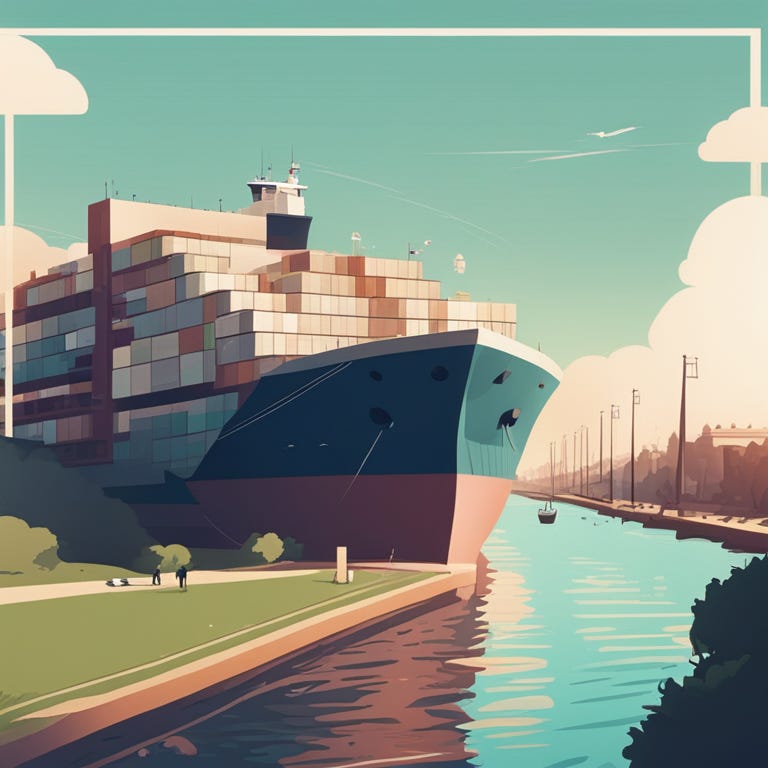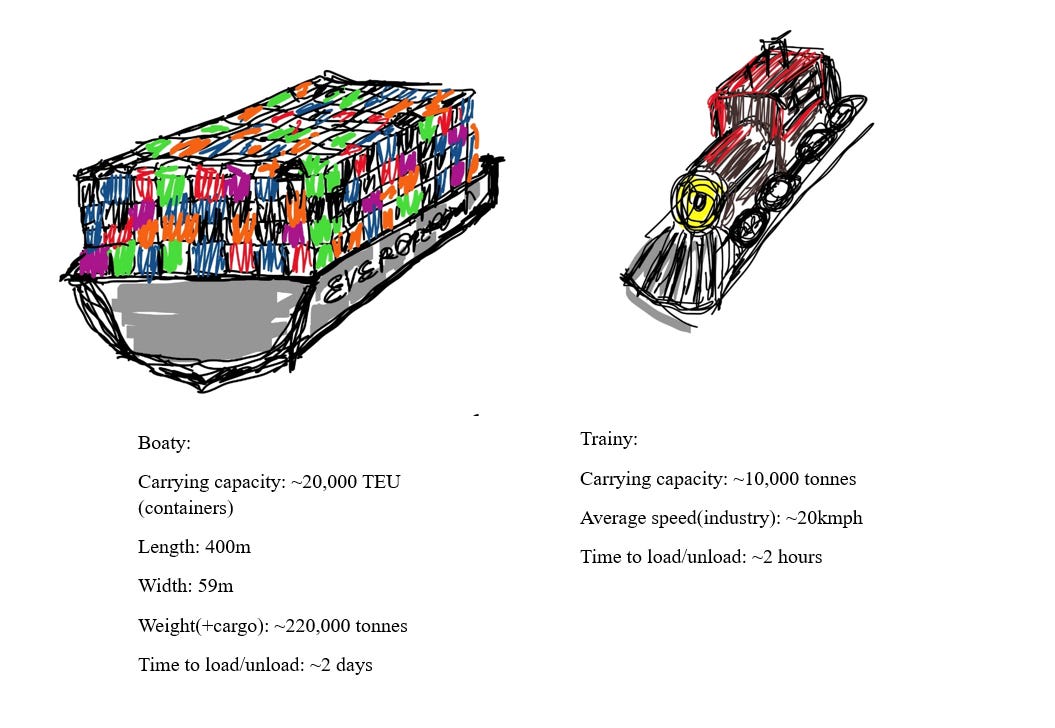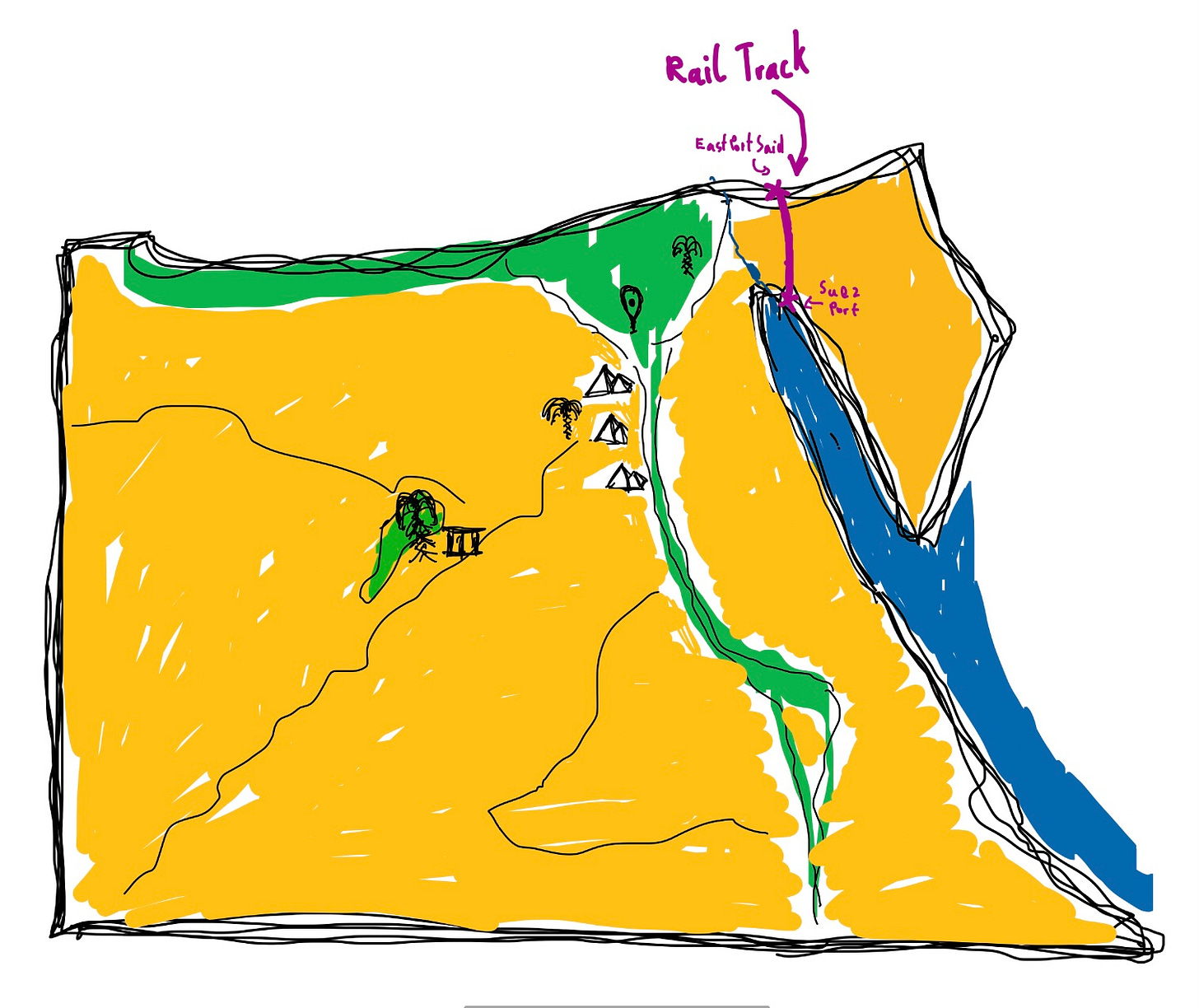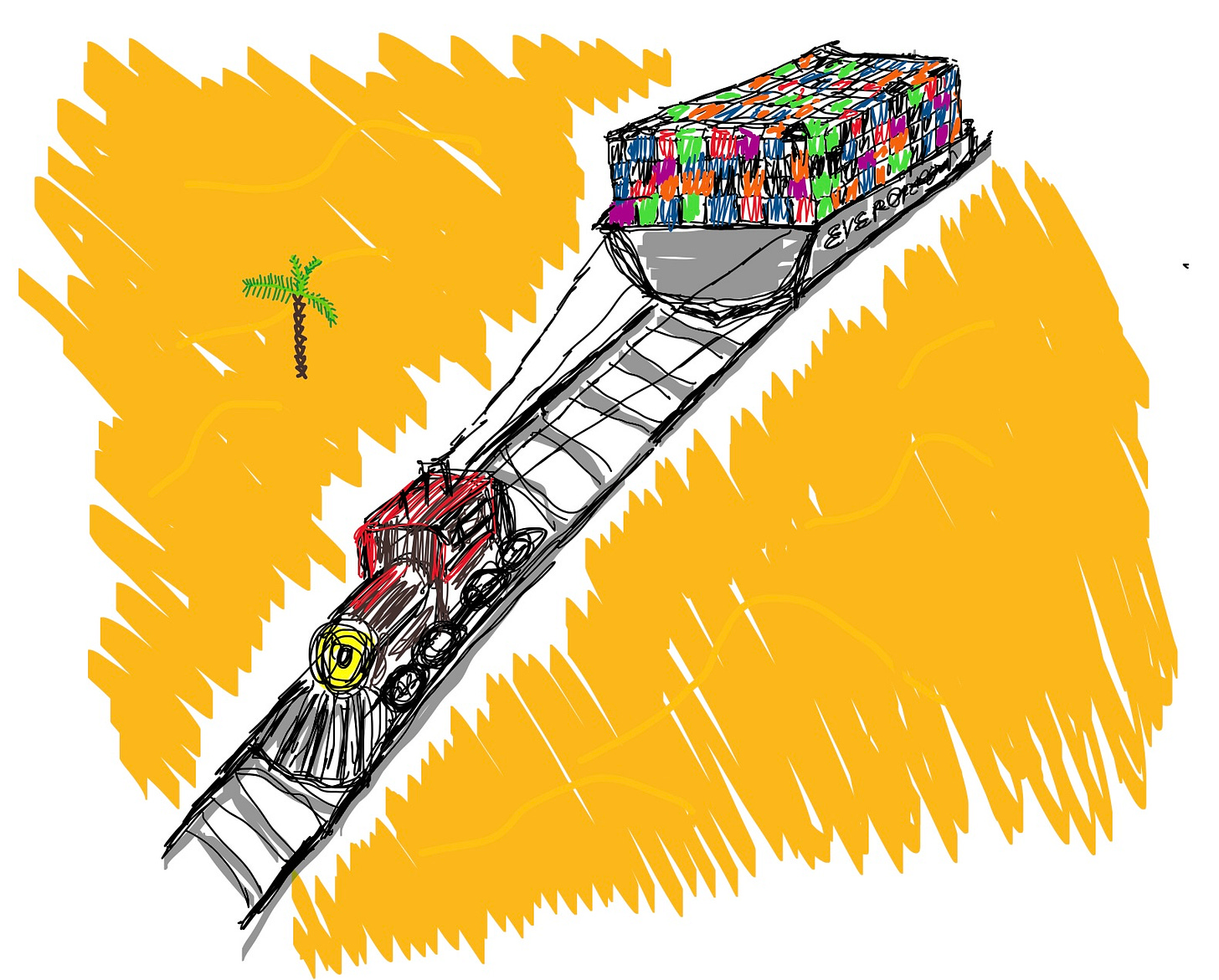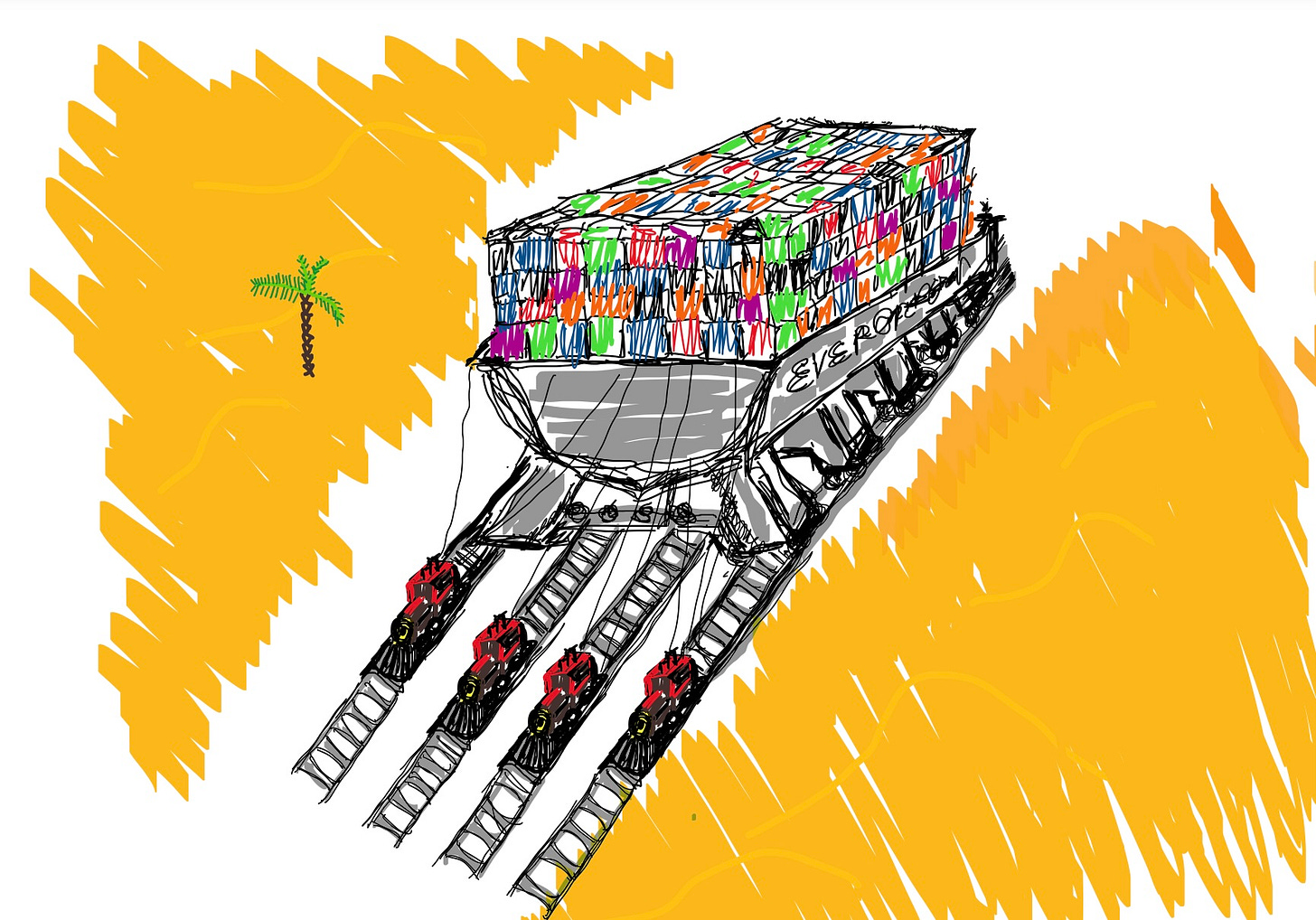Go Big or Go Around
The passage of time determines who’s crazy and who’s a visionary
Hello everyone, today’s broadcast will be an exercise in pushing two idioms to the limits: ‘fail to prepare, prepare to fail’, and since everyone hates failure, why not ‘go big or go home’ with our preparation. Lets take a look at the Suez canal, why some think its importance may decline, and potential solutions that some people may potentially view with absolute confusion and skepticism. But who knows, they may be on the wrong side of history.
Bottlenecks
The Panama Canal and the Suez Canal are two of the most impressive and influential human feats of engineering, cutting days of travel around South America and Africa respectively. Every day hundreds of vessels are travelling to, through and from these chokepoints, (can be seen here, the snaking line of ships centered around these points). The Panama Canal boasts an incredible system of locks, used to elevate vessels to correct altitudes, and has recently undergone expansion to ensure ‘post-panamax ships’ (those really really BIG ships) can traverse through a new set of locks- they have their ship sorted out, if you will- lets dig into the Suez canal.
The Suez canal has also underwent expansion: creating new lanes so that ships can travel in opposite directions at the same time, rather than waiting for one ship to pass before another can travel through. Last year, it managed to have over 22,000 ships travel through it(Statista, 2023), being a vital artery connecting East and West. However it hasn’t all been plain sailing- The value of trade flowing through the canal means that time is precious- and any delays are incredibly expensive. And the pain isn’t localized either: delays through the canal means delays at the ports, leading to congestion when past ships arrive at the same time as current ships, with shortages of empty containers. All of these knock-on effects spill over into everyone’s lives with delays and higher costs. Take the case of the infamous Evergreen blockage, where it took months for all effects to wither away(Pittelli, 2021).
The evergreen saga damaged the reputation of the Suez canal, and suggests for alternatives one again began to trickle in. One is the Northern Sea Route(NSR) stretching along the northern coast of Russia. It have been slowly gathering steam over the years, with increasing cooperation between China and Russia(Waheed and Moazzam, n.d). Current issues which are holding the NSR back is that it is currently covered in ice for many months of the year, and floating icebergs pose a risk to vessels passing through(Waheed and Moazzam, n.d). But with global warming working its magic, it may become a viable alternative in the coming years, especially as it could offer a shorter and therefore cheaper route connecting Asia and Europe. Another is the Ben-Gurion canal, which would flow through Egypt, but with regards to its viability, the shovel has not yet hit the dirt, and remains mostly theoretical at this point.
One third option maybe to simply go back around the whole of Africa. With ships getting more and more efficient, the fuel costs are likely to lower and lower, negating some of the benefit of the Suez canal, and if the canal begins to have delays or waiting lines, the time related benefit can be marginalized as well. With larger fuel savings, no cost of transit across the Suez canal, travelling the old-fashioned way may come back in style.
In the face of different alternatives slowly dropping anchor and setting sail, Egypt may look to continue expanding the Suez canal, ensuring waiting times or delays are never a significant issue. But as we have briefly mentioned, some of the offered alternatives offer savings which the Suez canal may not be able to match. Therefore, Egypt may need to look elsewhere in order to maintain its influence on global trade. This is where the fun begins…
Re-inventing the Wheel
Is there a better way to enable vessels to travel through Egypt? It is the thinnest part of land that separates the Mediterranean from the Indian Ocean, which is a good start. Now, what’s the most efficient way to haul cargo long distance over land? Trains. One method widely used in North America is known as intermodal transportation(Slack, n.d): Ships arriving on the east coast, delivering their containers. These are then packed onto trucks, which deliver them onto freight trains. These trains carry containers across North America to the west coast, where the initial stages are reversed, so that ships are filled with these containers, which then travel onto the rest of the world. Egypt has began investing into such intermodal transportation infrastructure, so lets see if we can go a step further.
Although intermodal transportation has its benefits, it is also very complex, and requires 2 different ships to be at the beginning and end of such a link. The infrastructure costs are also significant, and it just may not be time-efficient- Some of these calculations are vastly simplified and estimates are averages, but serve to paint a clear enough picture: let’s say the infamous Evergiven had a sister ship called ‘Boaty’ and a there was the new Shen24 (one of the most powerful electronic locomotives(Alexey and Ekaterina, 2023)) named ‘Trainy’.
For Boaty’s containers to be fully unloaded it would take approximately 2 days. For its cargo to be loaded onto Trainy, not only is another 2 hours needed, but approximately a team of 20 Trainy’s is needed to fully service all of Boaty’s cargo). Now, this train needs to go somewhere, so we need to find an area where the train tracks can be laid. Luckily, the westen Sinai Peninsual has relatively flat land, so lets assume the tracks lead from the Suez Port to the East Port Said (Approximately 150km).
If we apply an average speed of freight trains(~20kmph) to the distance required, we get a travel time of around 7.5 hours. After arriving to its destination Trainy’s need to be unloaded, and Boaty #2 loaded, leading to overall transport time of 4 days 11.5 hours. This is the roughest of estimates, and it isn’t necessary for cargo to all end up on the same ship. But for comparison, it takes around 12-16 hours to traverse through the Suez canal. So intermodal transport may help, but unlikely to offer a better route. But what if we carry both Boaty and its cargo through train? Let me introduce to you the concept of “Neo amphibious freight transport (NAFT)” ( I should copyright this)
Now it couldn’t happen like this: current trains have pulling capacity much lower than the weight of a fully loaded Boaty. But its not just the weight- it’s the weight distribution. Trains carry their sizes in kilometer long caravans, while Boaty is only 400 meters long. Such dense cargo is likely to bend and overstress the rails themselves. Another consideration are axle’s themselves: the heaviest axle loads (maximum load per axle) on rail has been achieved in Australia, with 40 tons per axle(Soler, 2022).
To reduce the average axle weight what can we do? Lower the overall weight (no fun), or increase the number of axles. Therefore, I propose having multiple railways running parallel, simultaneously increasing the number of axles, improving the weight distribution, and adding the ability to have additional Trainy’s available to pull Boaty along. With 5,000 axles, we have lowered the weight, enough down to the maximum axle load. With multiple parallel railways, huge supports can be created, studded with axles, which would help stabilize Boaty while on the track, further improving distribution of weight, so that multiple rail lines support Boaty’s fish out of water experience.
The train tracks would be going through a section of the Sinai desert, so additional considerations would need to be made in order to deal with the temperature and sand. Hot temperatures during the day and cold temperatures during the night will result in expansion and contraction of metals used in construction, while sand can lead to deterioration of the train track. Both of these factors need to be accounted for or negated. Trains have been operating in desert conditions for decades, so ready-made solutions should be available. Another consideration is the wind- although it isn’t unusually windy, the large flat side of Boaty can often act like a large sail (this a reason as to why the Evergiven ran aground in the Suez canal), and these forces may destabilize Boaty while on train travel. Once everything is accounted for, this is what it may look like:
It would certainly be a sight to see, but if we are honest, this idea is likely to never leave paper in the near future. Any semi-competent engineer is likely throwing up at the thought of all the unanswered issues. But new technologies are constantly being produced, which may help with achieving Boaty’s dream: there is recognition of the benefits of improving maximum axle loads, the advent of maglev trains may redefine freight transport, which may mean this might actually become a viable option. Lets not forget, it’s the passage of time that determines who’s crazy, and who’s a visionary.
Containerization 2.0
Perhaps an alternate solution would be create and use bigger containers? Currently the world largely runs one standard 20 foot containers (they really are like the red blood cells of the human body, delivering oxygen[cargo] around the entire body). There are variations, such as the 40 foot or 12 foot container, but this standard has been adopted worldwide. Containerization revolutionized the world, reducing shipping costs hundredfold, and containerization of containers may do the same thing. Container ’packs’ could be made, where containers are bound to a skeletal structure, so that they can be loaded or unloaded multiple containers at a time: picture a 12 pack of juice boxes (or beer, whichever comes to your imagination quicker I don’t judge). While current systems and infrastructure may not be ready to immediately implement these container ‘packs’, the switch over to these may mean this is the most feasible option of the ones we are going to see today.
One innovation that is currently occurring is likely to vastly improve shipping is the advent of smart containers (everything is getting smart nowadays). These smart containers essentially have a large number of sensors and a status attached to them. They can then constantly transmit data about whereabouts, time of travel, whether it is empty or not; any damage or break-ins. This development will lead to more efficient logistical systems with lower loss and greater security. But how can this help Egypt maintain its influence over trade? By also having a smart container storage system, like the one that was prototyped by DP World:
‘BoxBay’ is meant to revolutionize how containers are stored. Instead of being directly on top of one another in a large area, this creation intends to have containers automatically placed by an autonomous system, which would know everything about the containers, especially its arrival date. For instance, containers that are seen as express delivery likely need to be placed within close reach, and less urgent ones can be placed further. Check out how it would here.
Now, lets go back to thinking outside the container: What if cargo vessels were able to have a smart storage system of their own, enabling them to shuffle cargo mid-transit for instant. Although even now containers are placed in an optimum location depending on when they need to reach port, this process is done whenever they are in a port. Containers are taken away, some are shuffled around, and then more added. Imagine if on the way to the port, the cargo vessel can arrange it so all out-bound containers are on the very top. These are then taken off, and those needed to be added are done so. Then during the vessels trip to its next destination, the shuffling of containers takes place on the voyage, saving time by minimizing instances when ships are not shipping and idling in ports. This could improve speed of overall freight travel, improving the feasibility of intermodal transport in Egypt.
If cargo vessels could have smart storage of containers on board, the next step could be to make the storage modular and not permanently attached to the ship, or ‘modular container storage (MCS)’(going to have to copyright this one too): the container storage sections of the ship could be lifted of the ship one module at a time, transported by freight train to the East Port Said, and reassembled back onto the deck of a different Boaty. The entire container storage could be temporarily disassembled into smaller, more manageable modules, for easier transportation, and reassembled again like an incredibly heavy, 3D jigsaw puzzle. This would have the benefit of quicker unloading times, more technically feasible due to the smaller sizes of freight involved, with the additional benefit of flexibility: container storage modules from our beloved Boaty could be spread to different ships, depending on the final destination of these containers.
Hopefully this broadcast proved a fun thought experiment in trying to solve a problem that is not occurring yet. But what I am sure of is that it will be fascinating to watch the future of cargo vessels and the routes they take. If anyone knows some good patent lawyers or patent offices, feel free to reach out to me.
There’s some polls down below, feel free to answer :)
That’s all from me for now, but stay tuned for future broadcasts,
This has been Kunga’s Written Radio,
Alexey, S. & Ekaterina, S. (2023). 'World’s most powerful electric locomotive shen24 by crrc for coal cargo service in china', [Online]. Available at: https://rollingstockworld.com/locomotives/worlds-most-powerful-electric-locomotive-shen24-by-crrc-for-coal-cargo-service-in-china/#:~:text=service%20in%20China-,World's%20most%20powerful%20electric%20locomotive%20Shen24%20by,coal%20cargo%20service%20in%20China&text=China%3A%20The%2028.8%20MW%2024,operation%20began%20in%20June%202021.
Pittelli, L. (2021). 'The suez canal ship is freed, but headaches will linger for months'. Industry Week [Online]. Available at: https://www.industryweek.com/supply-chain/logistics/article/21160223/the-suez-canal-ship-is-freed-but-headaches-will-linger-for-months.
Slack, D. J.-P. R. a. D. B. (n.d). 'Intermodal transportation and containerization', 5.6. The Geography of Transport Systems [Online]. Available at: https://transportgeography.org/contents/chapter5/intermodal-transportation-containerization/#:~:text=Intermodal%20transportation%20relies%20on%20an,refer%20to%20containerized%20rail%20transportation. (Accessed 18/08/2023).
Soler, C. (2022). 'Axle load in a railway', [Online]. Available at: https://grabcad.com/tutorials/axle-load-in-a-railway#:~:text=The%20track%20is%20used%20by,axle%20loads%20of%2022.5%20tons.&text=32.5%20tons%2Faxle%20(standard%20in,to%20achieve%2040%20tons%2Faxle.
Statista (2023). Number of ships passing through the suez canal from 1976 to 2022: Statista. Available at: https://www.statista.com/statistics/1252568/number-of-transits-in-the-suez-cana-annually/ (Accessed: 15/08/2023).
Waheed, A. & Moazzam, M. (n.d). 'Alternatives to egypt’s suez canal: Russia’s northern sea route & israel’s ben-gurion canal'. Paradigm Shift [Paper] [Online]. Available at: https://www.paradigmshift.com.pk/egypts-suez-canal/ (Accessed 18/08/2023).




